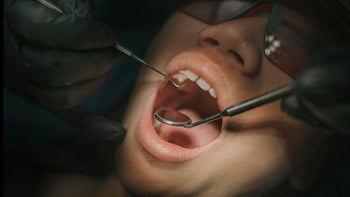
How Much Does a Dental Bridge Cost?
Key takeaways:
A dental bridge can cost from about $2,000 and to more than $5,000.
The type of bridge and its material can greatly impact the amount you pay.
Some dental insurance plans help to cover the cost of a dental bridge.
Table of contents

If you've got a gap in your mouth where a tooth should be, your dentist may recommend a dental bridge. This tooth replacement option bridges the space created by missing teeth.
While dental bridges are an effective way to replace missing teeth, they can be costly. To help you prepare financially for this procedure, we've compiled some information on typical costs for dental bridges.
What is a dental bridge?
A dental bridge is an artificial tooth (or teeth) used to fill the space left by one or more missing teeth. The bridge is attached to the natural teeth on either side of the gap. Unlike partial dentures that you can remove, dental bridges are fixed in place.
Search and compare options
Are there different types of dental bridges?
Your dentist may recommend one of four types of dental bridges. The location of your missing tooth and the condition of your nearby teeth all play a role in determining which one you’ll need.
The different types of bridges are:
Traditional bridge: Also known as a fixed bridge, this is the most common type of dental bridge. Your fitting will involve placing crowns on the teeth on either side of the gap to cement the fake tooth or teeth in position.
Cantilever bridges: Cantilever bridges are used with one supporting tooth. The fake tooth is attached to this support tooth with a connector called a cantilever.
Maryland bridges: A Maryland bridge, also called a resin-bonded bridge, is usually used to replace teeth in the front of your mouth. This typically involves attaching metal wings to the fake tooth and bonding it to the supporting tooth without irreversible damage.
Implant-supported bridges: As you might guess from the name, implant-supported bridges are anchored by dental implants. This option is usually the most costly and is often recommended if you are missing multiple teeth in a row.
What are the requirements for getting a dental bridge?
While bridges work well for many people, they aren't always the right tooth replacement option.
Here are some factors dentists consider when determining whether or not you're a good candidate for a dental bridge:
The number of teeth you're missing: Dental bridges often replace one tooth, but can be used for four or more missing teeth. If you need a full-mouth reconstruction, you'll need to consider other options, such as implants or dentures.
The condition of your remaining teeth: The teeth adjacent to the gap must be strong enough to support the dental bridge.
The overall state of your dental health: You must have good oral health and healthy gums to qualify for dental bridges. If you have gum disease or a weak or deteriorated jawbone, you may not be a good candidate.
Your oral hygiene habits: Good oral hygiene is essential for people with dental bridges. Without proper care, bacteria can build up and you can develop an infection.
Your overall health: People with certain health conditions or who smoke may not be good candidates for implanted dental bridges. These conditions include diabetes, cancer, and certain autoimmune diseases.
Dental implants: A dental implant is an artificially rooted tooth that’s permanently affixed to the jaw. Learn about the cost of dental implants and how to make this procedure more affordable.
Is a dental savings plan right for you? If you don’t have dental insurance, you could benefit from this membership program. Find out how dental savings plans work and how they can help you save.
More savings tips: Here are some creative ways to save on dental care that you might not have considered or tried before.
After reviewing your health history, your dentist can help decide if you qualify for a dental bridge.
How much does a dental bridge typically cost?
The cost of a dental bridge depends on numerous factors.
According to Authority Dental, a national dentistry information source, prices in the U.S. can start at around $1,500 for a Maryland bridge and cost as much as $16,000 for an implant-supported dental bridge.
Read more like this
Explore these related articles, suggested for readers like you.
A 3-unit bridge can cost $2,500 to $4,000, according to Authority Dental. For a bridge without an implant, expect to spend about $1,300 for each additional tooth if you have a larger gap.
Dentaly.org reports that a standard 3-unit bridge can cost $500 to $1,500. The same device secured by an implant can cost $5,000.
The price depends on factors such as:
How many teeth you're missing: Bridges that replace more than one tooth are more expensive.
The type of bridge you get: Dental bridges supported by implants cost more.
The material used for the fake tooth: Porcelain is the most popular choice because it most resembles the look of natural teeth. However, porcelain can be more expensive than other options. You may save money by choosing a different material.
What work needs to be done on the support teeth: If you have decay or damage to the tooth supporting the bridge, your dentist will want to take care of that first. That’ll add money to your overall estimate. An implanted bridge requires surgery, which raises costs.
To help you better calculate the price of your procedure, here are the average costs based on the type of bridge you get.
| Bridge type | Average cost for a single gap | Price range |
|---|---|---|
| Traditional | $2,500 | $2,000-$5,000 |
| Cantilever | $2,500 | $2,000-$5,000 |
| Maryland | $1,750 | $1,500-$2,500 |
| Implant-supported | $5,500 | $4,000-$16,000 |
These prices may not reflect the cost of dental bridges in your area. A local dentist is the best resource for an accurate estimate of what you can expect to pay.
What other costs might go along with getting a dental bridge?
As with any dental procedure, there are associated costs to consider. For a dental bridge, you also may pay for these services:
| Associated cost | Average price | Price range |
|---|---|---|
| Oral exam | $100 | $50-$200 |
| Dental X-rays | $35 | $25-$50 |
| Tooth extraction | $200 | $50-$500 |
| Local anesthesia | $90 | $40-$150 |
| Professional cleaning | $100 | $70-$250 |
Does insurance cover dental bridges?
Now that you know more about how much a dental bridge can cost out of pocket, let’s talk about whether insurance will cover any of the expenses. The answer depends on your dental health plan.
Private dental insurance often covers half the cost of major restorative procedures, such as a bridge. However, your plan’s maximum annual benefit or maximum lifetime benefit will apply. So if the covered cost exceeds your plan’s maximum benefit, you'll be responsible for paying the rest.
If you have an annual benefit, you may need to delay additional treatment until your policy resets. If you meet a lifetime maximum, you’ll have to pay out of pocket for all other dental work in that category as long as you have the same insurance plan.
In addition to only paying a part of the expense, some dental policies limit the number of bridges you can get within a certain period of time. For instance, you may be limited to one bridge every 5 years.
If you have an Affordable Care Act (ACA) marketplace health insurance plan, you may not have any dental coverage. These plans are required to provide dental coverage for children. These plans will offer separate dental plans that you can buy at the same time you select your health insurance plan.
If you're enrolled in original Medicare, it's important to note that Medicare will not cover most dental care, including bridges or dentures. However, many Medicare Advantage plans offer dental coverage or give you the opportunity to buy a separate dental plan.
Medicaid dental coverage varies by state. Medicaid covers dental care for enrolled children younger than age 21, which may include bridges. States are not required to provide dental care to adults enrolled in Medicaid. Most state Medicaid programs provide emergency dental care, but fewer than half offer comprehensive dental care. More than 30 state Medicaid programs cover restorative services and dentures, which may or may not include dental bridges. Some state Medicaid programs classify bridges as elective services.
Qualified veterans can receive dental services through the U.S. Department of Veterans Affairs.
What are ways to afford a dental bridge without insurance?
To help you lower your costs, here are a few other options to consider.
If you have a flexible spending account (FSA) or health savings account (HSA), you may be able to use those funds to cover some of your out-of-pocket costs for a dental bridge.
A dental discount plan can save you money if you don’t have dental insurance. Most of these plans have an annual membership fee and must be used with a participating network of providers. Discounts vary, but you may be able to save 10% to 60% of the costs for a bridge with a Humana dental discount plan.
In addition, you also may be able to request a payment plan. Some dentists offer financing options that make it easier to afford the cost of a dental bridge.
Can I get a free dental bridge?
If you can't afford to pay for a dental bridge, there are some ways you may be able to get help.
Seniors, veterans, people with disabilities, and people with low incomes may be able to get free and low-cost dental bridges.
Some programs that offer this service include:
Give Back a Smile for domestic violence survivors
Donated Dental Service for veterans as well as people who have special needs, disabilities, or are medically fragile
State and local resources, including health departments
Are dental bridges permanent?
There are different types of dental bridges. All are fixed in place and expected to last for 5 to 15 years — and maybe longer.
Sometimes partial dentures held in place by metal clasps are called a removable dental bridge, but these are not permanent.
Is getting a dental bridge worth it?
A dental bridge can help restore your mouth and your overall oral health. For many people, a dental bridge is worth the cost. It’s less expensive than a complete set of dental implants and often more comfortable than dentures.
Dentures might be a better choice if you’re looking for the most affordable option to fill a gap in your mouth or replace many missing teeth. However, they are harder to keep in place and must be removed to clean.
A dental bridge to replace missing teeth has pros and cons. Here are some advantages and challenges to help you decide if getting a dental bridge is the right choice for you.
| Advantages of dental bridges | Challenges of dental bridges |
|---|---|
| It's comfortable to wear once your mouth adjusts | You have to maintain good oral hygiene to prevent decay |
| You'll be able to speak and chew normally or without previous pain | The appliance can become loose over time and may need to be replaced |
| It can improve the appearance of your smile and boost your self-confidence | Your supporting teeth may need additional work to prepare for the bridge |
Are there dental bridge alternatives I should consider?
There are alternatives to a dental bridge that could meet your needs. Full dentures, partial dentures, and dental implants can fill gaps in your mouth.
Dentures are removable and typically less expensive than dental bridges. You can get a full set of traditional dentures for about $1,800. A partial set typically costs about $1,500. However, dentures can be difficult to keep in place.
Dental implants are more expensive and more permanent than a dental bridge, but they require surgery. You can expect to pay about $4,800 for an implant of one tooth. If you want to have your full mouth done, the cost can exceed $40,000.
The bottom line
A dental bridge can help you replace one or more missing teeth. The appliance can cost from $2,000 to more than $5,000 depending on materials and the number of missing teeth. A dental bridge supported by an implant can cost more than $10,000. Unlike partial dentures, a dental bridge is attached to nearby teeth and fixed in place.
If you have dental insurance, you can expect to pay less out of pocket. If you don’t have insurance, you may be able to afford a dental bridge with a dental discount plan. You also may qualify for a free or low-cost dental bridge.
Why trust our experts?


References
American Dental Association. (n.d.). Affordable care act marketplace.
American Student Dental Association. (n.d.). U.S. dental schools.
Artisan Dental. (n.d.). How many teeth can dental bridges replace.
Aspen Dental. (n.d.). Dental bridge cost & offers.
Berry, R., et al. (2022). Dental bridge cost, materials, problems, benefits, and alternatives. Dentaly.org.
Center for Healthcare Strategies, Inc. (n.d.). Medicaid adult dental benefits coverage by state.
Dental Lifeline Network. (n.d.). State programs.
Dinkel, D. (2022). What are alternatives to dental implants? Costs, procedure, pros and cons comparison. Authority Dental.
Give Back a Smile. (n.d.). American academy of cosmetic dentistry charitable foundation.
Hattaway, R. (2022). Is dental insurance worth it? Learn more about cost, coverage, and waiting periods. Authority Dental.
Healthcare.gov. (n.d.). Dental coverage in the marketplace.
Humana. (n.d.). The scoop on dental discount plans.
March, P. (2022). How much does a dental bridge cost without insurance? Authority Dental.
Medicaid.gov. (n.d.). Dental care.
Medicaid and CHIP Payment and Access Commission. (n.d.). Medicaid coverage of adult dental services.
Medicare.gov. (n.d.). Dental services.
McKenna, N., et al. (2022). What is a dental bridge? Types and procedure. Authority Dental.
Renew Family Dental. (n.d.). 5 Ways dental bridges improve oral health.
Strietzel, F. P., et al. (2019). Implants in patients with oral manifestations of autoimmune or muco-cutaneous disease— a systematic review. Medicina Oral, Patología Oral y Cirugía Bucal.
The National Association of Free & Charitable Clinics. (n.d.). National association of free & charitable clinics.
U.S. Department of Health & Human Services. (n.d.). Where can I find low-cost dental care?
U.S. Department of Veteran Affairs. (n.d.). VA dentistry- improving veterans’ oral health.
United Healthcare. (n.d.). Dental coverage with medicare advantage.



























